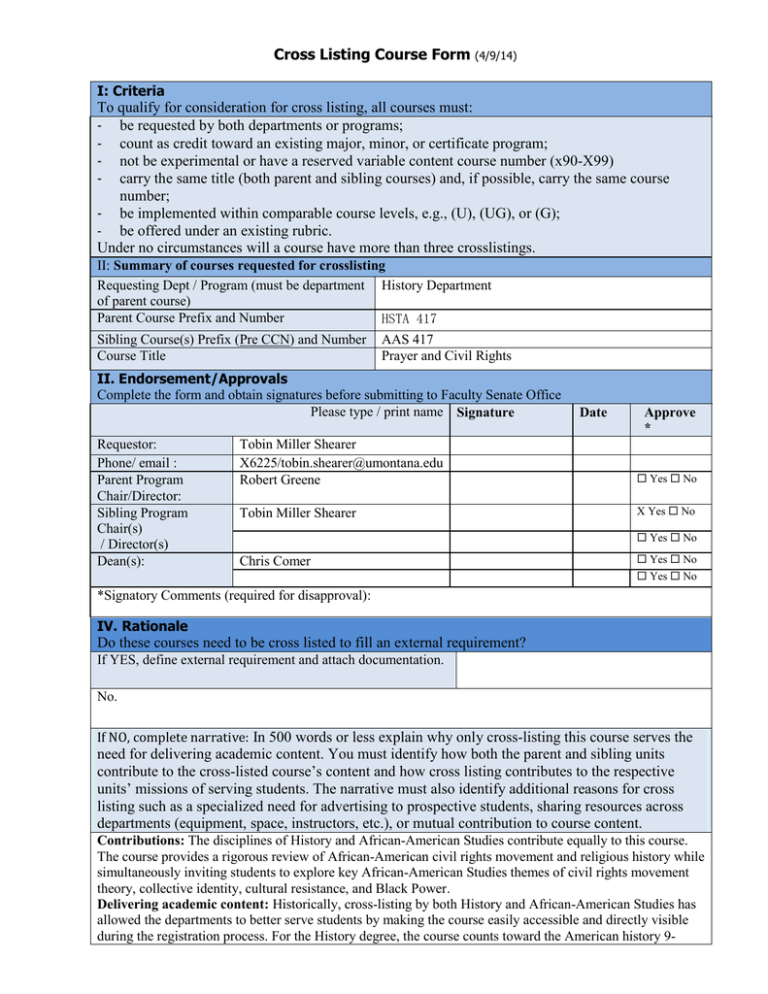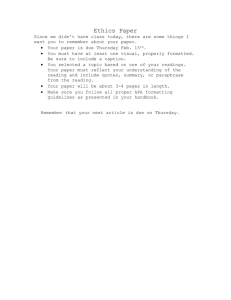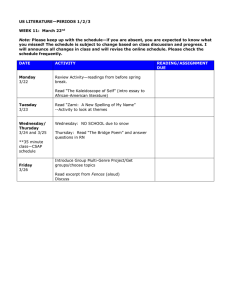Cross Listing Course Form
advertisement

Cross Listing Course Form (4/9/14) I: Criteria To qualify for consideration for cross listing, all courses must: - be requested by both departments or programs; - count as credit toward an existing major, minor, or certificate program; - not be experimental or have a reserved variable content course number (x90-X99) - carry the same title (both parent and sibling courses) and, if possible, carry the same course number; - be implemented within comparable course levels, e.g., (U), (UG), or (G); - be offered under an existing rubric. Under no circumstances will a course have more than three crosslistings. II: Summary of courses requested for crosslisting Requesting Dept / Program (must be department History Department of parent course) Parent Course Prefix and Number HSTA 417 Sibling Course(s) Prefix (Pre CCN) and Number AAS 417 Course Title Prayer and Civil Rights II. Endorsement/Approvals Complete the form and obtain signatures before submitting to Faculty Senate Office Please type / print name Signature Requestor: Phone/ email : Parent Program Chair/Director: Sibling Program Chair(s) / Director(s) Dean(s): Date Approve * Tobin Miller Shearer X6225/tobin.shearer@umontana.edu Robert Greene Yes No Tobin Miller Shearer X Yes No Yes No Chris Comer Yes No Yes No *Signatory Comments (required for disapproval): IV. Rationale Do these courses need to be cross listed to fill an external requirement? If YES, define external requirement and attach documentation. No. If NO, complete narrative: In 500 words or less explain why only cross-listing this course serves the need for delivering academic content. You must identify how both the parent and sibling units contribute to the cross-listed course’s content and how cross listing contributes to the respective units’ missions of serving students. The narrative must also identify additional reasons for cross listing such as a specialized need for advertising to prospective students, sharing resources across departments (equipment, space, instructors, etc.), or mutual contribution to course content. Contributions: The disciplines of History and African-American Studies contribute equally to this course. The course provides a rigorous review of African-American civil rights movement and religious history while simultaneously inviting students to explore key African-American Studies themes of civil rights movement theory, collective identity, cultural resistance, and Black Power. Delivering academic content: Historically, cross-listing by both History and African-American Studies has allowed the departments to better serve students by making the course easily accessible and directly visible during the registration process. For the History degree, the course counts toward the American history 9- credit requirement. For Af-Am, the course fulfills one of two core course electives. Advertising to prospective students: At the University of Montana, African-American Studies faculty work proactively to recruit students to their classes by offering engaging pedagogy, high academic standards, and strong support for interested students. Cross-listing has been an essential component of the overall recruitment strategy. Specialized need: In short, at a majority-white institution, Af-Am faculty need every possible measure to keep the program viable and growing. Cross-listing provides a key advertising method to meet the specialized need of a minority program in a majority setting. Mutual contribution: Likewise, cross-listing of these two courses offers immediate recognition of the mutual contribution that both departments/programs make to the course. Both departments place a strong value on delivering the widest possible curriculum offerings as students pursue their degrees. The crosslisting mechanism introduces students easily and directly to courses that they might not otherwise consider and demonstrates in the mechanism itself the high value that both departments place on each other’s respective disciplines – an instructional method in and of itself that sends the message that disciplines can and should be in constant conversation. V. Syllabus AAS/HSTA 417 Prayer and Civil Rights Autumn 2014 Tobin Miller Shearer Tuesdays and Thursdays, 12:40-2:00 p.m., NAC 202 With knees bent and heads bowed, a group of fervent African-American activists prepared to pray on the sidewalks of Albany, Georgia, in 1963. A few minutes later, dour-faced police officers arrested the young people and removed them from the sidewalk to a local jail. Such pious action deserves careful scrutiny. Built around the question, “Does religion help or hinder the pursuit of social change?” this class combines historical and religious studies methods to trace changes in civil rights activists’ efforts to make use of religion. By focusing on a particular religious practice – in this case prayer – in a specific but limited period of time, this course challenges students to examine African-American history and religion from two primary perspectives. First, students will consider how historical action forms meaning, in this case through the public recitation of appeals to divine authority. Secondly, students will study the social significance of religious practice by examining how African-American Christians articulated a rationale for change, appealed to commonly held ethical values, and evoked the assurance of divine support. This course thus complicates prevailing ideas about the normalcy of African-American religious practitioners’ prayer, invites students to examine their assumptions about the nature of prayer, and traces how religion spilled out of sanctuaries into the streets. Objectives: students will be able to – - ask purposeful questions about religious practice and answer them creatively; - differentiate among and explain the major characteristics of the ritualistic, rhetorical, and political aspects of Christian prayers; - identify significant shifts in the Civil Rights Movement between 1948 and 1976 and describe where, when, and how civil rights actors used prayer in public; - use resources from the disciplines of African-American history and religious studies to analyze primary source documents; - develop, revise, and defend written arguments explaining the meaning of a specific instance of public prayer. Assignments: Each week’s classes will include input on religious theory and African-American history, opportunities for student discussion, topical readings, and regular writing assignments. In all classroom activities, students will draw on readings from both religious studies theory and AfricanAmerican civil rights history. This course is designed to support each student in writing a 20-page research paper that analyzes a set of primary sources including video footage of prayers by grassroots civil rights activists, written prayers, and sound recordings of civil rights activists giving public prayers. The research paper will be submitted once as a research topic, once as an outline, once as an initial draft, once as a second draft, and once as a final draft with the expectation that each draft will improve upon the previous one. In order to receive full credit for the paper, each draft must be submitted in full. This course fulfills the Upper Division Writing Course requirement. Grading: Participation – 20% Research paper – 80% Each day you earn points for your participation. If you attend, show evidence of having read the assigned reading, and contribute to the class discussion, you will receive four points for that day. You can earn up to 108 points in the course of the semester out of a 100-point scale (which gives you two days of unexcused absences if you need them or a chance to improve your overall grade by attending every day and doing the readings). Points will be posted each class day on the course Moodle site. If you are absent for an excused reason, you will need to write a one-page, singlespaced reflection on the week’s reading for each day missed due one week after the excused absence. Each research paper is worth 200 points. You can earn those points in the following manner: 1) turn in a clearly focused, 3-4 sentence research topic by the assigned date = 15 points 2) turn in a paper outline: a. on time = 5 points b. meets minimum length requirement = 5 points c. identifies the ten secondary sources that will be used = 10 points 3) turn in draft one of a research paper: a. on time = 5 points b. meets minimum length requirement (19 ½ pages) = 10 points c. is written with complete sentences in standard paragraph form = 5 points d. includes two student-identified primary sources plus those provided in class = 5 points 4) turn in draft two of a research paper: a. on time = 5 points b. meets minimum length requirement (19 ½ pages) = 10 points c. is written with complete sentences in standard paragraph form = 5 points d. includes two student-identified primary sources plus those provided in class = 5 points e. demonstrates clear improvement on previous draft = 5 points 5) turn in final draft of research paper a. on time = 10 points b. meets all criteria of the research paper rubric = 100 points (pro-rated according to grade scale below) Grade scale: A+ 98-100 A 93-97 A- 90-92 B+ 87-89 B 83-86 B- 80-82 C+ 77-79 C 73-76 C- 70-72 D+ 67-69 D 63-66 D- 60-62 F ≤59 Class size: Enrollment is limited to 20 students. Classroom etiquette: I expect that all students will join me in creating a supportive and focused learning environment by: - turning off all cell phones (and thus doing no texting, e-mailing or instant messaging); - using laptops only for note taking; - not doing crosswords, reading newspapers, or other recreational activities; - not talking with fellow classmates unless instructed to do so. During lectures, I will give you my complete attention. I ask the favor of the same from my students. Should a student’s behavior interrupt our learning environment, he or she will first be given a private verbal warning. Upon second infraction, the student will receive a public warning. Should disruptive behaviors continue following two warnings, the student will be issued a warning in writing. Any subsequent disruptive behaviors will be turned over to the University’s disciplinary committee. Instructor contact: I maintain regular office hours that I will post on the course website. You are also welcome to contact me by e-mail. My goal is to respond within 24 hours. In case of emergency, you may contact me by phone as listed on the course website. Missed deadlines: My goal is always to encourage your best work in the midst of multiple classroom demands and real life emergencies. Limited deadline extensions can be arranged if the student makes advance contact. Late assignments will be marked down 10 points/day up to the full value of the individual assignment (research paper steps 1-5 above). Academic honesty: Stealing someone else’s ideas is the same as stealing someone’s property. Cite others’ ideas in standard footnote or endnote format (in written work and all projects). Paraphrase whenever possible. In general, a paraphrase uses no more than two of the same words in a sentence as the original source. See: http://www.umt.edu/vpsa/policies/student_conduct.php for a full review of the University of Montana’s student conduct code. Accessibility: The University of Montana assures equal access to instruction through collaboration between students with disabilities, instructors, and Disability Services for Students. If you think you may have a disability adversely affecting your academic performance, and you have not already registered with Disability Services, please contact Disability Services in Lommason Center 154 or 406.243.2243. I will work with you and Disability Services to provide an appropriate modification. Readings: Chapman, Mark L. Christianity on Trial: African-American Religious Thought before and after Black Power. Maryknoll, NY: Orbis Books, 1996. Marsh, Charles. God's Long Summer: Stories of Faith and Civil Rights. Princeton, NJ: Princeton University Press, 1997. Payne, Charles M. I've Got the Light of Freedom: The Organizing Tradition and the Mississippi Freedom Struggle. Berkeley: University of California Press, 1995. Wuthnow, Robert. After Heaven: Spirituality in America since the 1950s. Los Angeles: University of California Press, 1998. Course pack (available on course website): Alexander, Bobby Chris. “Correcting Misinterpretations of Turner’s Theory: An African-American Pentecostal Illustration.” Journal for the Scientific Study of Religion 30 (1991): 26-44. Balmer, Randall. “Mississippi Missions.” In Mine Eyes Have Seen the Glory: A Journey into the Evangelical Subculture in America, expanded ed., 176-192. New York: Oxford University Press, 1993. Bell, Catherine M. “Constructing Ritual.” In Ritual Theory, Ritual Practice, 19-29. New York: Oxford University Press, 1992. ---------. “Constructing Meaning.” In Ritual Theory, Ritual Practice, 30-46. New York: Oxford University Press, 1992. Costen, Melva Wilson. “Worship in the Invisible Institution.” In African American Christian Worship, 2nd. ed., 25-37. Nashville, TN: Abingdon Press, 2007. Findlay, James. “Churches Join the Movement.” In The Civil Rights Movement, edited by Paul A. Winters, 141-49. San Diego: Greenhaven Press, 2000. ---------. “Religion and Politics in the Sixties: The Churches and the Civil Rights Act of 1964.” The Journal of American History 77, no. 1 (1990): 66-92. Garrow, David J. “Religious Resources and the Montgomery Bus Boycott.” Criterion 34 (1995): 29. James, William. “The Reality of the Unseen.” In The Varieties of Religious Experience: A Study in Human Nature, 53-76. New York: Random House, 1902. ---------. “Mysticism.” In The Varieties of Religious Experience: A Study in Human Nature, 379429. New York: Random House, 1902. Krause, Neal, and Linda M. Chatters. “Exploring Race Differences in a Multidimensional Battery of Prayer Measures among Older Adults.” Sociology of Religion 66, no. 1 (2005): 23-43. Livingston, James C. “Sacred Ritual.” Anatomy of the Sacred: An Introduction to Religion, 80103. New York: Macmillan, 1989. Moore, R. Laurence. “The African Future of Christianity.” In Touchdown Jesus: The Mixing of Sacred and Secular in American History, 89-108. Louisville, KY: Westminster John Knox Press, 2003. Orsi, Robert A. “Everyday Miracles: The Study of Lived Religion.” In Lived Religion in America: Toward a History of Practice, edited by David D. Hall, 3-21. Princeton, NJ: Princeton University Press, 1997. Smart, Ninian. “Introduction.” Dimensions of the Sacred: An Anatomy of the World's Beliefs, 126. Berkeley: University of California Press, 1996. Zaleski, Philip, and Carol Zaleski. “The Ecstatic.” In Prayer: A History, 158-194. New York: Houghton Mifflin Co., 2005. ---------. “Prayer and the Public Square.” In Prayer: A History, 294-310. New York: Houghton Mifflin Co., 2005. Schedule: Week 1 - August 26 & 28: Introduction to course, religion, civil rights movement Reading due Thursday: Zaleski and Zaleski, “Prayer and the Public Square.” Week 2 – September 2 & 4: Major themes in Civil Rights Movement historiography Reading due Thursday: Payne. Library Research Session in Buckhouse Room on Thursday, September 4. Week 3 - September 9 & 11: Civil Rights Movement 1 – 1940-1955 Reading due Thursday: Garrow. Research Paper topic due by Wednesday at 11:59 pm. Week 4 – September 16 & 18: Civil Rights Movement 2 – 1956-1963 Reading due Thursday: Findlay, “Churches Join the Movement.” Week 5 – September 23 & 25: Civil Rights Movement 3 – 1964-1974 Readings due Thursday: Balmer; Findlay, “Religion and Politics in the Sixties.” Week 6 – September 30 & October 2: The Broad American Religious Context Reading due Thursday: Wuthnow. Research Paper Outline due by Wednesday at 11:59 p.m. Week 7 – October 7 & 9: African-American Religious Context Readings due Thursday: Costen; Krause and Chatters; Moore. Week 8 – October 14 & 16: Religious Theory 1 – What is religion? Readings due Thursday: James, “The Reality of the Unseen”; Smart. Week 9 – October 21 & 23: Religious Theory 2 – What is ritual? Readings due Thursday: Alexander; Bell, “Constructing Ritual”; Livingston. Week 10 – October 28 & October 30: Religious Theory 3 – What is prayer? Readings due Thursday: Bell, “Constructing Meaning;” James, “Mysticism”; Zaleski and Zaleski, “The Ecstatic.” Week 11 – November 6: Reading Prayer into Civil Rights Movement History No class on Tuesday, election day. Exercise your right to vote! Reading due Thursday: Marsh. Research Paper Draft 1 due by Wednesday at 11:59 p.m. Week 12 – November 13: Reading Prayer out of Civil Rights Movement History No class on Tuesday, Veterans Day. Reading due Thursday: Orsi. Week 13 – November 18 & 20: In-class intensive writing workshops No readings due this week. Week 14: November 25 & 27: No classes. Writing and revision week and Thanksgiving break. No readings due this week. Research Paper Draft 2 due by Sunday, November 30, at 11:59 p.m. Also include one paragraph describing the changes that you made since your last draft and why you made them. Week 15 – December 2 & 4: Thinking Faith into African-American Religion Reading due Thursday, Chapman. Wednesday, December 3, Soup and Pie Night, Dr. Shearer’s House, 1020 S. Grant St., Unit B, Missoula, MT 59801: 6-9 p.m. Finals week Class will meet during our scheduled exam time, Tuesday, December 9, 3:20-5:20. Each student will give an informal ten-minute description of the major findings and argument of their paper. Research Paper Final Draft due by Thursday, December 11, at 11:59 p.m. Also include one paragraph describing the changes that you made since your last draft and why you made them. VI. Justification for third crosslisting: In 500 words or less describe the extenuating circumstances making a third course necessary. VII Copies and Electronic Submission. After approval, submit signed original, and electronic file to the Faculty Senate Office, UH 221, camie.foos@mso.umt.edu.

